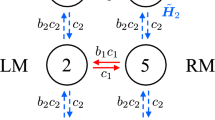Abstract
Central pattern generators (CPGs) are ubiquitous neural circuits that contribute to an eclectic collection of rhythmic behaviors across an equally diverse assortment of animal species. Due to their prominent role in many neuromechanical phenomena, numerous bioinspired robots have been designed to both investigate and exploit the operation of these neural oscillators. In order to serve as effective tools for these robotics applications, however, it is often necessary to be able to adjust the phase alignment of multiple CPGs during operation. To achieve this goal, we present the design of our phase difference control (PDC) network using a functional subnetwork approach (FSA) wherein subnetworks that perform basic mathematical operations are assembled such that they serve to control the relative phase lead/lag of target CPGs. Our PDC network operates by first estimating the phase difference between two CPGs, then comparing this phase difference to a reference signal that encodes the desired phase difference, and finally eliminating any error by emulating a proportional controller that adjusts the CPG oscillation frequencies. The architecture of our PDC network, as well as its various parameters, are all determined via analytical design rules that allow for direct interpretability of the network behavior. Simulation results for both the complete PDC network and a selection of its various functional subnetworks are provided to demonstrate the efficacy of our methodology.
Supported by Portland State University and NSF DBI 2015317 as part of the NSF/CIHR/DFG/FRQ/UKRI-MRC Next Generation Networks for Neuroscience Program.
Access this chapter
Tax calculation will be finalised at checkout
Purchases are for personal use only
Similar content being viewed by others
References
Cohen, A.H., Bard Ermentrout, G., Kiemel, T., Kopell, N., Sigvardt, K.A., Williams, T.L.: Modelling of intersegmental coordination in the lamprey central pattern generator for locomotion. Trends Neurosci. 15(11), 434–438 (1992). http://linkinghub.elsevier.com/retrieve/pii/016622369290006T
Deng, K., et al.: Neuromechanical model of rat hindlimb walking with two-layer CPGs. Biomimetics 4(1), 21 (2019). http://www.mdpi.com/2313-7673/4/1/21
Duysens, J., Van de Crommert, H.W.: Neural control of locomotion; Part 1: the central pattern generator from cats to humans. Gait Posture 7(2), 131–141 (1998). http://linkinghub.elsevier.com/retrieve/pii/S0966636297000428
Forrest, S.: Genetic Algorithms. ACM Comput. Surv. 28(1), 4 (1996)
Frazier, P.I.: A tutorial on Bayesian optimization. arXiv:1807.02811 (2018)
Guertin, P.A.: The mammalian central pattern generator for locomotion. Brain Res. Rev. 62(1), 45–56 (2009). http://linkinghub.elsevier.com/retrieve/pii/S0165017309000812
Hunt, A., Szczecinski, N., Quinn, R.: Development and training of a neural controller for hind leg walking in a dog robot. Front. Neurorobot. 11, 18 (2017). http://journal.frontiersin.org/article/10.3389/fnbot.2017.00018/full
Ijspeert, A.J.: A connectionist central pattern generator for the aquatic and terrestrial gaits of a simulated salamander. Biolog. Cybern. 84(5), 331–348 (2001). http://link.springer.com/10.1007/s004220000211
Ijspeert, A.J., Kodjabachian, J.: Evolution and development of a central pattern generator for the swimming of a lamprey. Artificial Life 5(3), 247–269 (1999). http://direct.mit.edu/artl/article/5/3/247-269/2322
Mantziaris, C., Bockemühl, T., Büschges, A.: Central pattern generating networks in insect locomotion. Develop. Neurobiol. 80(1–2), 16–30 (2020). http://onlinelibrary.wiley.com/doi/10.1002/dneu.22738
Rubin, J.E., Shevtsova, N.A., Ermentrout, G.B., Smith, J.C., Rybak, I.A.: Multiple rhythmic states in a model of the respiratory central pattern generator. J. Neurophys. 101(4), 2146–2165 (2009). http://www.physiology.org/doi/10.1152/jn.90958.2008
Stevenson, P.A., Kutsch, W.: A reconsideration of the central pattern generator concept for locust flight. J. Compar. Phys. A 161(1), 115–129 (1987). http://link.springer.com/10.1007/BF00609460
Szczecinski, N.S., Hunt, A.J., Quinn, R.D.: Design process and tools for dynamic neuromechanical models and robot controllers. Biolog. Cybern. 111(1), 105–127 (2017). http://link.springer.com/10.1007/s00422-017-0711-4
Szczecinski, N.S., Hunt, A.J., Quinn, R.D.: A functional subnetwork approach to designing synthetic nervous systems that control legged robot locomotion. Front. Neurorobot. 11, 37 (2017). http://journal.frontiersin.org/article/10.3389/fnbot.2017.00037/full
Thompson, S., Watson, W.H.: Central pattern generator for swimming in Melibe. J. Exper. Biol. 208(7), 1347–1361 (2005). http://journals.biologists.com/jeb/article/208/7/1347/16006/Central-pattern-generator-for-swimming-in-Melibe
Acknowledgement
The authors acknowledge support by Portland State University and NSF DBI 2015317 as part of the NSF/CIHR/DFG/FRQ/UKRI-MRC Next Generation Networks for Neuroscience Program.
Author information
Authors and Affiliations
Corresponding author
Editor information
Editors and Affiliations
Rights and permissions
Copyright information
© 2022 The Author(s), under exclusive license to Springer Nature Switzerland AG
About this paper
Cite this paper
Scharzenberger, C., Hunt, A. (2022). A Functional Subnetwork Approach to Multistate Central Pattern Generator Phase Difference Control. In: Hunt, A., et al. Biomimetic and Biohybrid Systems. Living Machines 2022. Lecture Notes in Computer Science(), vol 13548. Springer, Cham. https://doi.org/10.1007/978-3-031-20470-8_37
Download citation
DOI: https://doi.org/10.1007/978-3-031-20470-8_37
Published:
Publisher Name: Springer, Cham
Print ISBN: 978-3-031-20469-2
Online ISBN: 978-3-031-20470-8
eBook Packages: Computer ScienceComputer Science (R0)




